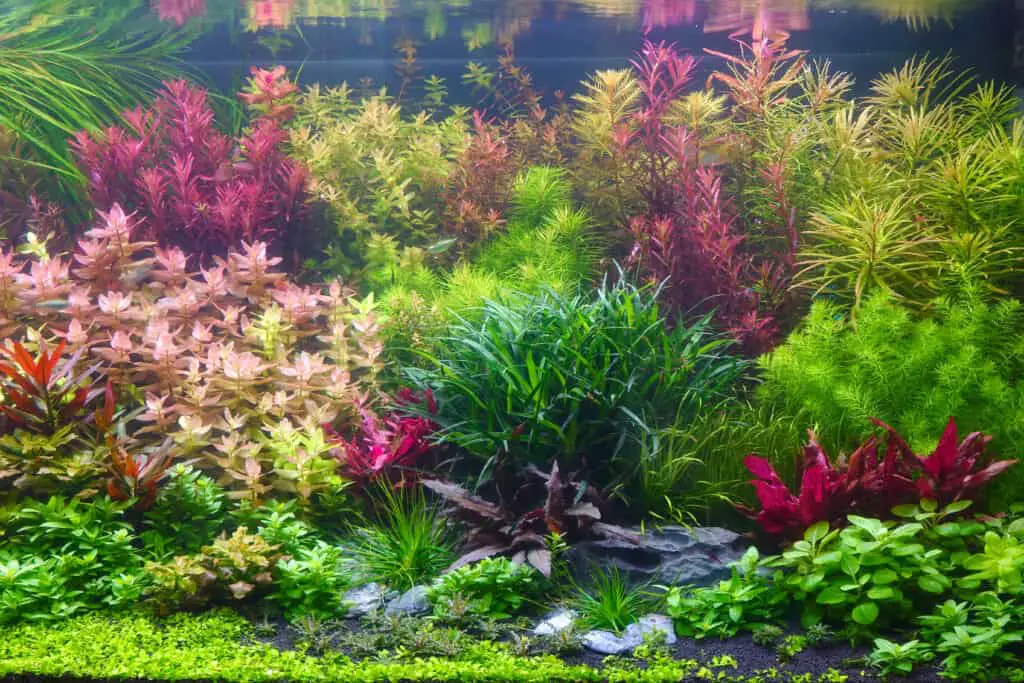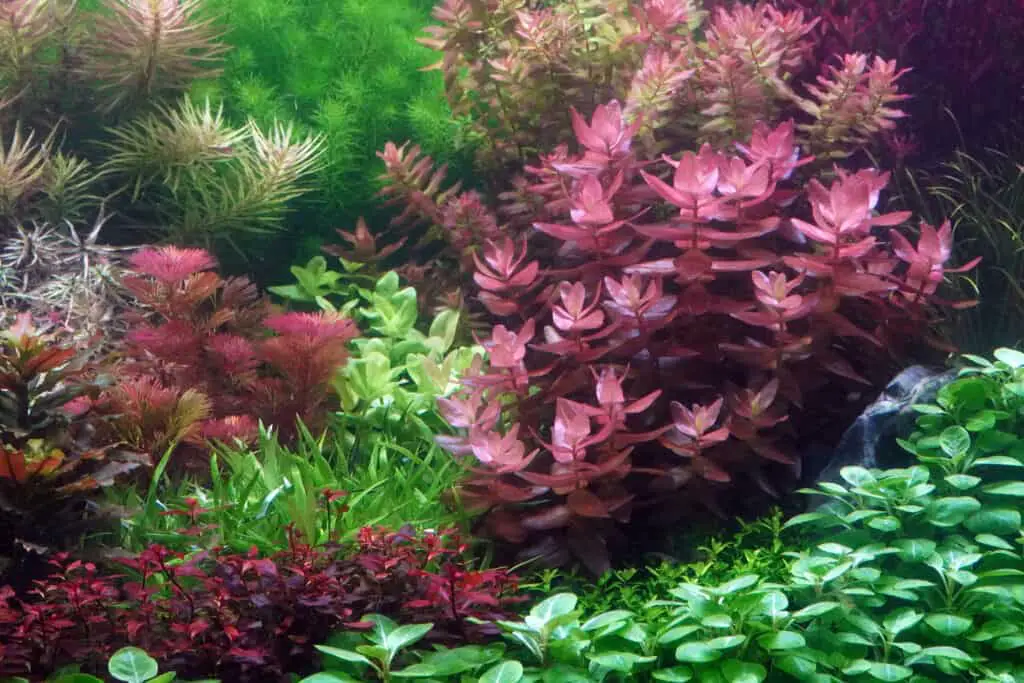
Whether new to plant tanks, or a veteran, understanding the arrangement of your plants in a tank is important to bringing a cohesive aquatic environment.
Plants not only bring extra beauty to your tank, providing an appealing backdrop to your fish and other tank inhabitants but can help create and maintain a balanced ecosystem.
In general, plants should be arranged by height and fullness, with taller, fuller plants placed towards the back, and shorter or less full plants placed frontward.
This will provide a plant landscape that appears to be filled in, give depth, and be balanced.
Plus assist in the overall maintenance of the plants by making them all more accessible.
Some aquarists may shy away from this if the desire is to go outside the box or to follow a specific planting style.
Let’s explore the world of aquatic plants to help transform your tank, either new or existing, into an underwater paradise.

Understanding Your Tank Environment and Plant Choice
The first step in knowing how you should arrange your plants in an aquarium is understanding the exact tank environment you are working with.
This is not only vital in giving the best chance for success for your plants, but will also help narrow down which plants should be selected, so they will thrive and give you the results you are looking to achieve.
Your Tank Parameters and Setup
There are a few things to assess when figuring out an arrangement that involves the overall setup of your tank, and what features are available to you in it.
These include the substrate you are using, the physical dimensions of your tank, the lighting both strength and length, and the water parameters you have.
Tank Size
The overall dimensions of your tank come into play because different plants will require different amounts of light, as well as grow to different heights.
Some plants for shorter or smaller tanks may not be suitable for the tank, depending on the amount of maintenance you are wanting to do.
Keeping the plants trimmed to levels where they aren’t outgrowing your tank may be more frequent.
On the flip side, plants that would be considered too small for larger tanks may work great in smaller tanks.
Knowing the dimensions will help narrow down your selections which will help immensely in arranging your plants.
This is also true in their placements, as with taller plants in smaller tanks, they will look best in the back, so that smaller plants will still be visible, and you can still access the shorter plants without disturbing the taller plants.
However, in larger tanks, those same plants may be better placed in the mid-ground, or maybe in extremely large tanks even the foreground.
Lighting
Your available lighting will determine the types of plants you will be able to successfully use in your tank.
The first part of lighting is the overall duration that you can have your light on.
Most plants do the best with 12-14 hours of light.
The strength is the second part to consider, and this will also vary based on the height of your tank.
As the tank gets taller, more powerful light will be needed to have the light effectively reach the bottom of the tank.
Plants that are considered high-light plants will need stronger light compared to low-light plants.
Substrate
Another factor that should be considered is the substrate being used in your tank, and other decorations such as rocks and wood.
Plants that prefer to be out of the substrate, like rhizome plants would benefit from being attached to something like rock, wood, or other decorations, as it will cause issues to the plant if placed in the substrate.
If you plan to have rhizome plants, be sure to know this as it will change where plants can be placed in the tank, depending on where your rocks and decorations will be.
Water Parameters
Ideal parameters for most aquatic plants are a pH between 6.5 and 7.8, a general hardness of 50-100 ppm, and alkalinity between 54-140 ppm.
If your tank parameters are outside of these ranges, it doesn’t mean that plants won’t survive, but it might take longer for them to adapt to your parameters, this will usually show in the way of plant melt.
If you want to learn more about plant melting, read my article here.
It is important to research the plants you would like to use, and consider looking at plants that do well closer to your tank parameters, or consider using additives to bring your tank water parameters closer to the desired ones of the plants,
This will help in your plants becoming established, and therefore being able to arrange them knowing they will grow as expected.
Choosing Your Plants
After finalizing your tank setup, you will then be able to have a better understanding of the plants that will be best suited for you.
When arranging your plants, you want to remember that there should be some variation in the heights of plants, typically these will be designated on the plants as being foreground, midground, and background.
Foreground plants will typically be slower-growing plants and should be placed up front.
Midground plants do well being placed in the middle level of your plants.
The background plants will typically be the faster-growing plants that will do well in the back.
It would help if you also considered the level of maintenance you are willing to perform, lower maintenance plants will generally be labeled as beginner-friendly and will be pretty bulletproof to varying tank parameters and care levels.
Remember to choose plants that will complement each other in size, varying the foreground, midground, and background plants to help in the arrangement to create a dense and deep landscape.

Planning the Layout of Your Planted Tank
Once you have your tank setup finalized and your plants chosen, it is time to plan out your desired layout.
Even though you can simply place your plants in your tank immediately, it is better to think it out overall to decrease the amount of disturbance to your tank and having to constantly rearrange everything.
A piece of paper that has the bottom dimensions roughly sketched out is all that is needed, from there you can simply take your plants chosen and test out where they might go, knowing to place the plants in their respective recommended levels from back to front.
This would also be a good time to consider adding root tabs for your new plants to help in their growth and planning out where they might need to be placed.
This rough sketch will also help determine the amount of plants you should purchase.
Plants will grow, and in most cases propagate, so this determination is based mainly on the amount of space you want to fill in, and how long you are willing to wait between planting, and having the plants fill in.
If you want to have a dense and full look immediately, this will require purchasing more of the same plants to fill everything in.
If you are willing to let the plants fill in on their own, then fewer plants will be needed.
Also, remember that for most plants you will receive plants that can be split up into groups, so one purchased plant may give you more than one bundle if you are willing to have the plants grow denser on their own.
Final Thoughts
Having a goal in mind for your planted tank, and then creating a plan to achieve your goal may be the most important step in creating a lush, vibrant underwater oasis.
Knowing what you have available with your tank, and making sure you pick plants that will work with your vision, will help lead you on the path to creating the planted tank of your dreams.
